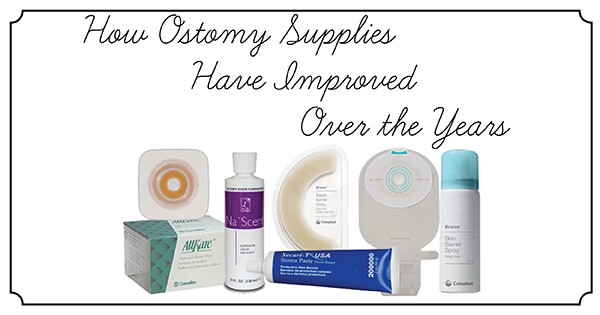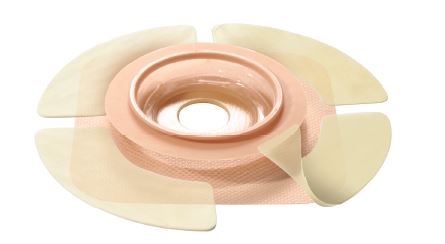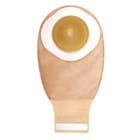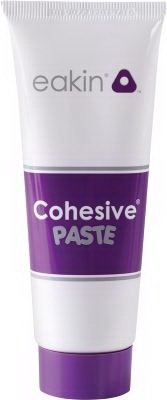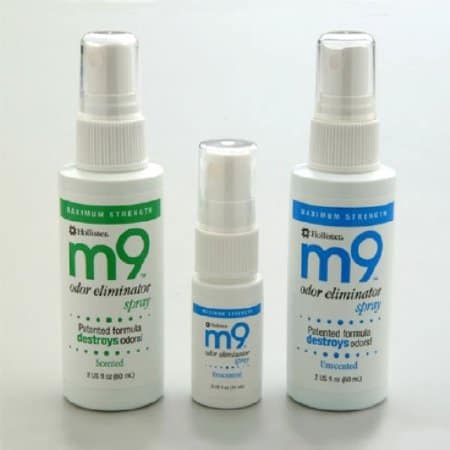Experiencing challenges with ostomy supplies is quite common among those with an ostomy. Some of those challenges can include skin irritations, leakage, and odors. Over the years, ostomy supplies have been invented in an attempt to address these complications. Today, ostomy supplies are better quality, safer, and most importantly, help improve quality of life.
What is an Ostomy Pouching System?
The ostomy pouching system is offered as either a one-piece or a two-piece flexible system consisting of an ostomy pouch and a skin barrier, sometimes referred to as a flange, wafer, device, or appliance. The skin barrier sits against the skin that surrounds the stoma and may be flat or convex (curved). A one-piece system combines both the barrier and pouch into one convenient unit. The entire one-piece system requires replacement when changing out since the skin barrier and pouch are attached. The two-piece system, however, is made up of a separate skin barrier and ostomy pouch. The two pieces are connected using a coupling ring, and when changing out, the existing pouch is removed, and a new one is attached while the skin barrier remains in place.
The Beginnings of Ostomy Systems
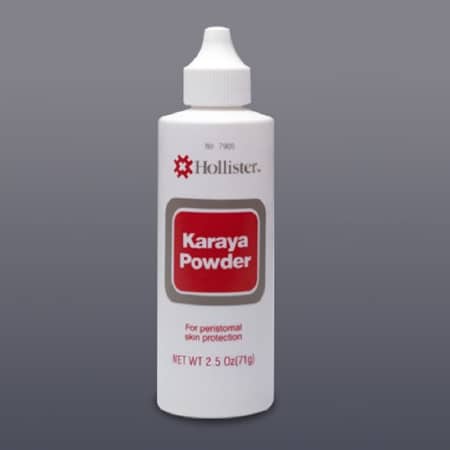 It is recorded as the year 1706 that the first stoma was created on a patient that resulted in a prolapsed colostomy from a battlefield wound. Later in 1776, a French physician formed a stoma on a patient that suffered from an intestinal blockage. An elastic band held a sponge over the stoma site on the abdomen to collect output. Then, for many years, stoma output was managed by ostomy supplies made of leather pouches with drawstrings or rubber pouches and plastic skin barriers held in place using adhesives and belts.
It is recorded as the year 1706 that the first stoma was created on a patient that resulted in a prolapsed colostomy from a battlefield wound. Later in 1776, a French physician formed a stoma on a patient that suffered from an intestinal blockage. An elastic band held a sponge over the stoma site on the abdomen to collect output. Then, for many years, stoma output was managed by ostomy supplies made of leather pouches with drawstrings or rubber pouches and plastic skin barriers held in place using adhesives and belts.
Over the next 60 years, ostomy supplies, surgical techniques, and patient care evolved. There were approximately 25 manufacturers of ostomy supplies by 1960 in the United States. Ostomy pouch materials were being tested to take away the bulk and heaviness of the rubber pouches being used. The result was a thinner plastic film that was more simple and functional. There are many ostomy pouches today that are constructed of quieter, water-repellent materials and help control odors.
When it came to ostomy, skin barriers, glass, and porcelain were used first. Then in the 1950s, zinc-based skin barriers were used to help protect the stoma and promote peristomal skin health. Later in the 1960s, a laboratory accident led to the discovery of Karaya powder, a natural hydrocolloid that absorbs moisture and protects peristomal skin under the barrier. Nowadays, skin barriers made of hydrocolloid material have become popular and used in most ostomy systems. Hydrocolloid skin barriers can help reduce skin irritation, offer a better seal for fewer leaks, and allow for a longer wear time.
Manufacturer's Focus Today
Today, many manufacturers focus more on the patient’s needs and create ostomy supplies with features that can help improve the fit and performance as well as the user’s quality of life.
Ostomy supplies today address various stoma types, such as retracted or recessed, protruding, or flush. Ostomy supplies such as deodorants, belts and wraps, filters, and seals have come a long way to help prevent leaks, odors, and security. And, the wide range of ostomy pouches that are now available address nearly every type of body type and lifestyle.
Ostomy Pouches Today
Fast-forward to the present, and you will find ostomy supplies that cover almost every concern those with an ostomy might encounter. There are ostomy pouches made of water-repellent, noise-reducing materials, films that help control odors, and many that feature filters to reduce ballooning from gas.
One-Piece Ostomy Systems
A one-piece ostomy system is a pouch and skin barrier combined into one single system. The skin barrier and the ostomy pouch cannot be separated. Manufacturers like Hollister, Coloplast, and ConvaTec, to name a few, carry a wide range of one-piece ostomy systems that cover a variety of user needs.
Two-Piece Ostomy Systems
Unlike the one-piece ostomy system, the two-piece ostomy system offers more flexibility when choosing a pouch and separate barrier since they are not permanently connected. When emptying or changing out the pouch, the skin barrier can remain in place, offering a quick and easy replacement. The two-piece ostomy system also puts less stress on the peristomal skin since the barrier is not being removed as frequently, causing skin friction and irritations.
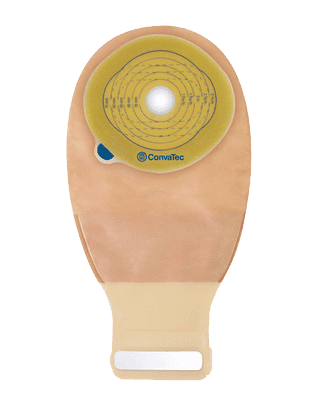 Drainable Ostomy Pouches
Drainable Ostomy Pouches
A drainable ostomy pouch allows the user to drain or clean and reattach to the skin barrier. Drainable pouches typically feature an EasiClose or InvisiClose style closure that uses Velcro to re-close the end. They can also feature other types of seals, such as a clamp or press and seal style. The drainable and reusable ostomy pouches can help cut down on costs since they can be reused.
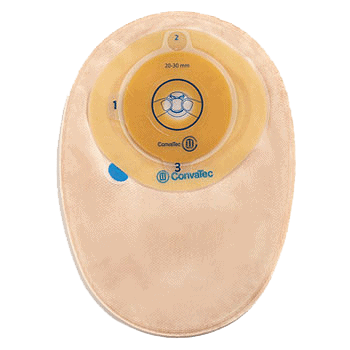 Closed-End Ostomy Pouches
Closed-End Ostomy Pouches
A closed-end ostomy pouch requires it to be discarded after it is full from output. The closed-end pouch might be a good choice for someone that doesn’t want to clean out their pouch. Offered in various shapes and sizes, a closed-end pouch can minimize the time and effort required for change-outs.
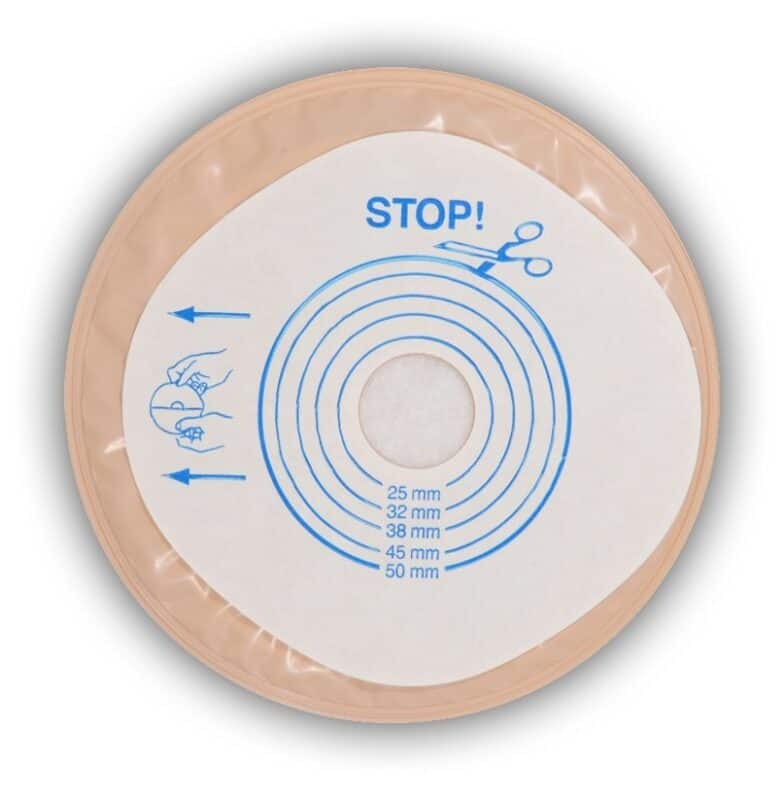 Stoma Caps
Stoma Caps
A stoma cap is the smallest ostomy pouch offered and is another type of closed-end system. The stoma cap is usually the choice for those with very active lifestyles, when being intimate, or for someone that has mastered irrigating their ostomy and has predictable output. Stoma caps are not meant to be worn for long periods since they do not have the capacity of a standard ostomy pouch.
Skin Barriers Today
Today, skin barriers are thinner and much more flexible than those of the past. Many skin barriers are designed to stick to the skin, have integrated closures, are more comfortable, and prevent leaks. Skin barriers are also designed for specific stoma types.
Flat Skin Barriers
If your stoma protrudes, you have deep abdominal creases, or a hernia, a flat skin barrier may be a good fit for you. A flat skin barrier is flexible and accommodates the body’s natural contours. An ostomy paste can fill any creases and create a smooth surface for the flat barrier to adhere nicely.
 Convex Skin Barriers
Convex Skin Barriers
If your stoma does not protrude, is flush with the abdomen, or is retracted slightly below the skin’s surface, a convex skin barrier may be the right choice for you. Flush and recessed or retracted stomas achieve a more significant protrusion using a convex skin barrier that applies gentle pressure around the stoma to increase protrusion.
Extended Wear Skin Barriers
Generally speaking, standard skin barriers have a shorter wear-time due to less resistance to liquid stool and urine. Standard wear skin barriers do not hold up to lengthy exposure to stool and urine and cause skin irritations because of frequent changes. An extended wear skin barrier, on the other hand, is formulated with substances that have a greater resistance to feces and urine. These substances absorb moisture causing the barrier to swell up around the stoma. Peristomal skin is protected with an extended wear skin barrier and helps reduce skin irritations.
Pre-cut Skin Barriers
If your stoma is round and the size is not changing, a pre-cut skin barrier may suit you. Pre-cut skin barriers offer a consistent stoma opening that doesn’t require cutting with ostomy scissors for an exact fit.
Cut-to-Fit Skin Barriers
If the size of your stoma is oval or changing dimensions, using a cut-to-fit style skin barrier might be a good choice. Since your stoma is an irregular shape and size, a pre-but skin barrier will not provide the tight seal needed to prevent leaks and potential skin irritations.
Moldable Skin Barriers
Moldable skin barriers offer the same benefit as a cut-to-fit skin barrier, but with some added features. Moldable skin barriers don’t require any scissors, resulting in an elastic seal that fits any stoma shape and size for a secure and snug fit. This technology helps prevent leakage issues, but it has also been an excellent skin barrier option to promote skin health.
Ostomy Accessories Today
Many ostomy accessories are available today that help make ostomy systems more comfortable depending on various needs.
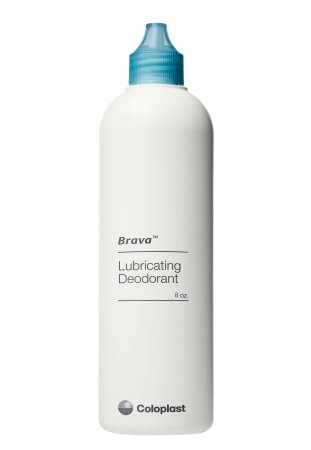 Ostomy Deodorants
Ostomy Deodorants
To keep an ostomy pouch smelling fresh and help kill odor-producing bacteria, ostomy deodorants can be used. The deodorants come in liquid drops, gels, sachets, or sprays and can be unscented or scented. When adding ostomy deodorants to a closed-end ostomy pouch, odors can be reduced when changing out the system. Some gel ostomy deodorants can also help make cleaning a drainable pouch easier by lubricating the pouch and eliminating odors left behind.
Adhesives & Adhesive Removers
One type of popular adhesive used for ostomy skin barriers is ostomy paste. This type of adhesive is used to fill in cracks and even out the skin’s contour so the skin barrier can have a better seal. The skin barrier will not stay in place when the skin’s surface is not smooth and flat. By using stoma paste, a reliable and strong seal is created that helps prevent leakage. Other adhesives are offered in the form of sprays, liquids, and roller ball applicators.
Once using an ostomy adhesive, an adhesive remover can gently break down the adhesive on the skin and the barrier. Many ostomy removers are sting-free and help to preserve the health of the delicate peristomal skin. Adhesive removers are available in the form of wipes and sprays to help remove rubber-based, acrylic-based, and hydrocolloid-based residues.
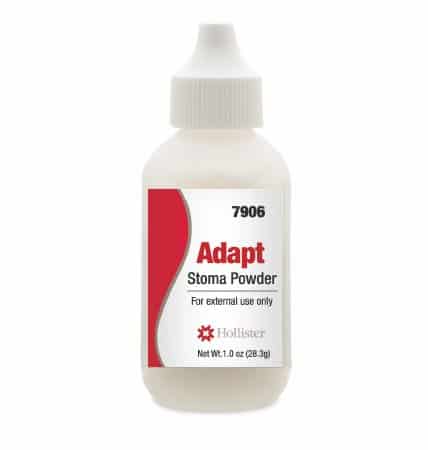 Ostomy Powders
Ostomy Powders
Ostomy powders work by absorbing moisture around the stoma to better seal a skin barrier. The powder will turn into a gel when wet but does not contain any adhesive. Ostomy powders are meant to be used only on raw or weepy peristomal skin to help protect the skin from further irritations and extend the wear time of an ostomy skin barrier.
Barrier Wipes & Sprays
Barrier wipes and sprays help reduce skin irritation from adhesives and friction by creating a protective chemical film on the peristomal skin. Barrier wipes and sprays are easy to use and can be combined with stoma powder to better seal the skin barrier. Simply apply the stoma powder and then top with a barrier spray and allow to dry.
 Ostomy Belts & Wraps
Ostomy Belts & Wraps
An ostomy belt is useful for securing an ostomy system to the body, protecting the seal, and preventing leaks. Ostomy belts and wraps are available in various styles and sizes to match any situation and can be an alternative to adhesives for sensitive skin. Those who lead active lifestyles can benefit from an ostomy belt since it can provide a sense of security when moving, twisting, and turning.
Ostomy Strips
The use of ostomy strips prevents the skin barrier from lifting and rolling, causing an insecure seal and leakage. Ostomy strips follow the body’s contours and move with the skin, creating a better sense of security and peace of mind that your barrier will stay in place during various activities. ConvaTec easeStrips are a popular ostomy strip that are flexible, thin, and made of hydrocolloid material to be skin-friendly and water-resistant.
Ostomy supplies offered today have made the ostomy system lighter weight, lower profile for comfort, and more discreet for confidence. At the end of the day, the goal is for those with an ostomy to get back to doing the things they enjoy most in life.
If you have any questions about the many ostomy supplies we offer at Personally Delivered, give us a call. Our Ostomy Product Experts are available to help you narrow down and choose what ostomy supplies are suitable for your specific needs or the person you are caring for. We are helping change people’s lives, one person at a time.
